Real-time Conversion and Playback
This mode is accessed via the "Play" menu button. It converts 2D video to 3D in real-time and displays it on the PC desktop in Side-by-Side or Top-Bottom 3D format. It supports MPC-HC, PotPlayer, and VLC media players. The 3D desktop view can then be streamed to a VR headset, 3D TV, or 3D projector to view the converted 3D video.
Though not itself a VR app, Stream to 3D works with Virtual Desktop and BigScreen's PC/VR streaming to enable 3D video viewing in VR headsets. It provides optimised configuration files for these apps.
This mode also supports 3D TVs and projectors via HDMI by outputting the 3D desktop view. The display devices can interpret the PC's HDMI input as SBS or TB 3D.
Playing a 2D Video in 3D
Stream to 3D starts in Full Screen mode to make it easy to use from within a VR headset. To switch to Windowed mode use the ALT+Enter key combination.
To play a video and have it converted to 3D as you watch it, click Play in the main menu and select the file. If you have the Configuration Wizard enabled, then you will be prompted for your preferences on how you would like the conversion to be handled, see here for guidance on the Configuration Wizard. You can enable and disable the Configuration Wizard or put it in "auto" mode from Settings. When disabled or in "auto" mode the Wizard preference questions are not displayed.
The file will be played in the current Stream to 3D media player. The name of the current media player is shown in the Output settings summary area, in this case it is MPC-HC:
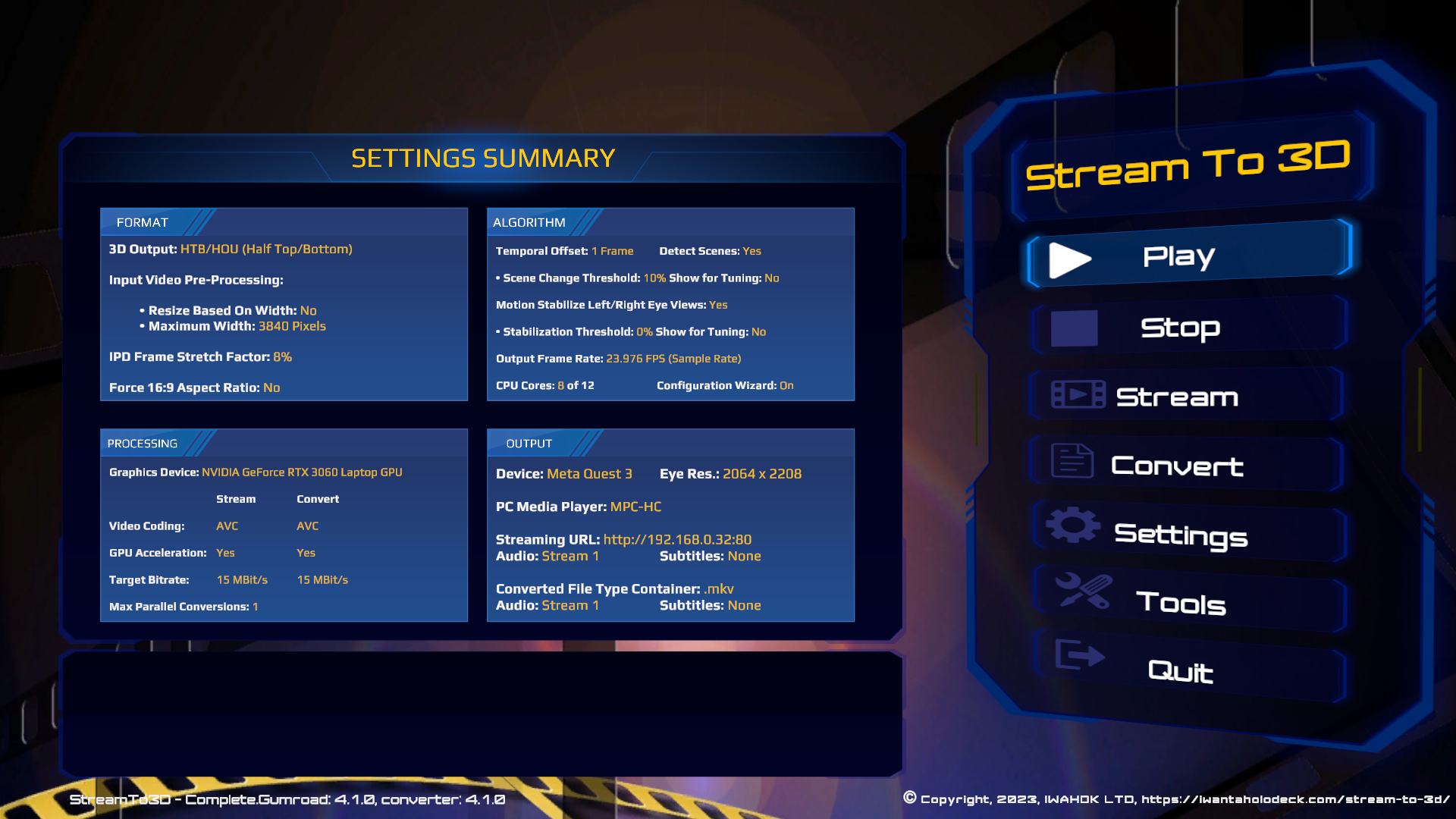
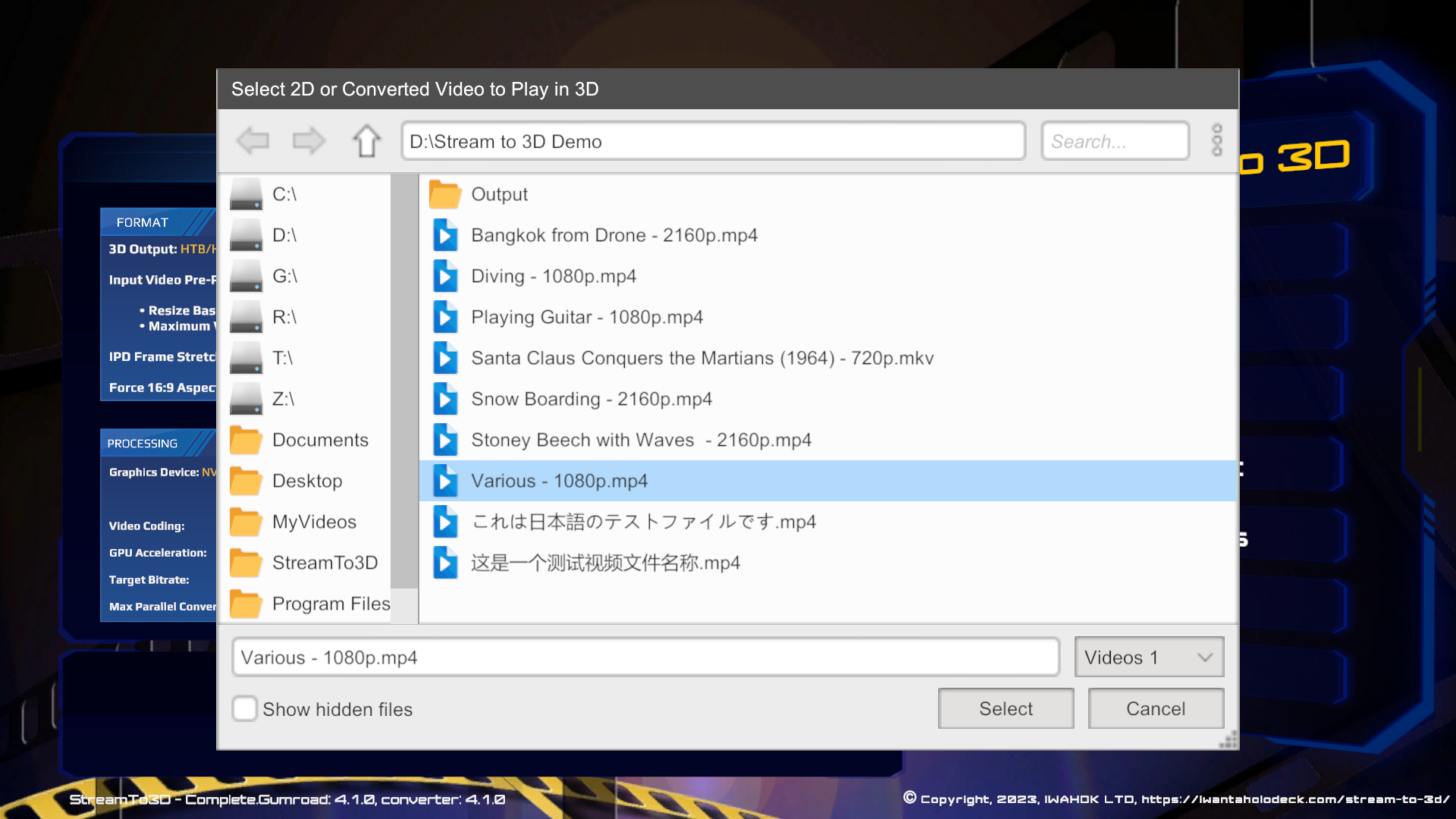
The video below provides a comprehensive demonstration and tutorial on Stream to 3D's real-time 2D to 3D conversion capabilities during video playback:
The guidance below provides further detail on additional tool configuration to get the most out of your Stream to 3D experience, together with Virtual Desktop and BigScreen video demonstrations.
Stream to 3D can also be used to play videos that are already in 3D format, perhaps having been previously converted to 3D by its conversion function or from external sources. Stream to 3D uses file name pattern matching to distinguish 2D from 3D videos. By default, it will bypass the 2D to 3D conversion function for files that have "3D" in their names or contain ".SBS.", ".TB.", ".HSBS.", ".HTB." or ".3DA." (these being the 3D output formats that Stream to 3D can generate). You can modify this pattern match in the "Settings/Format" menu. See here for details.
By default Stream to 3D is installed together with the K-Lite Mega Codec pack which, in addition to codecs, installs the MPC-HC media player. The latest version is supplied with the K-Lite codec pack.
If you have the Steam version of Stream to 3D, you can also install the optional media players, PotPlayer and VLC, as well as the VLC plugin for AviSynth, by running the optional tools installer:
StreamTo3DToolsOptionalSetup.cmd
This can be found in the Stream to 3D steam application folder, e.g.:
C:\Program Files (x86)\Steam\steamapps\common\Stream to 3D
If you did not install any of the optional media players (PotPlayer or VLC) and change the default player in the Tools menu then MPC-HC will be your default media player:
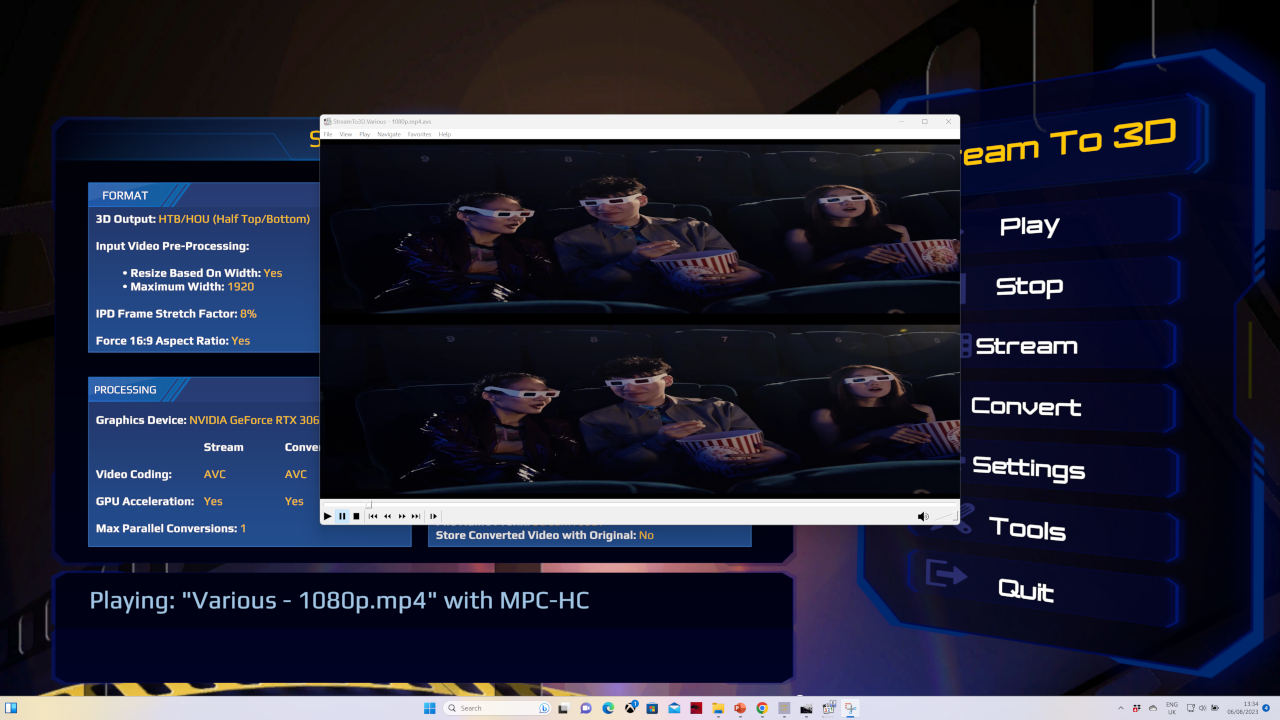
As you can see above, the default configuration of MPC-HC does not make the video playback in full-screen automatically. Function key "F11" or "ALT-Enter" can be used to switch in and out of Fullscreen mode in MPC-HC. However, we can do better by configuring MPC-HC to always start in Fullscreen mode, see screen shot below and the menu "View/Options/Fullscreen/Launch files in fullscreen":
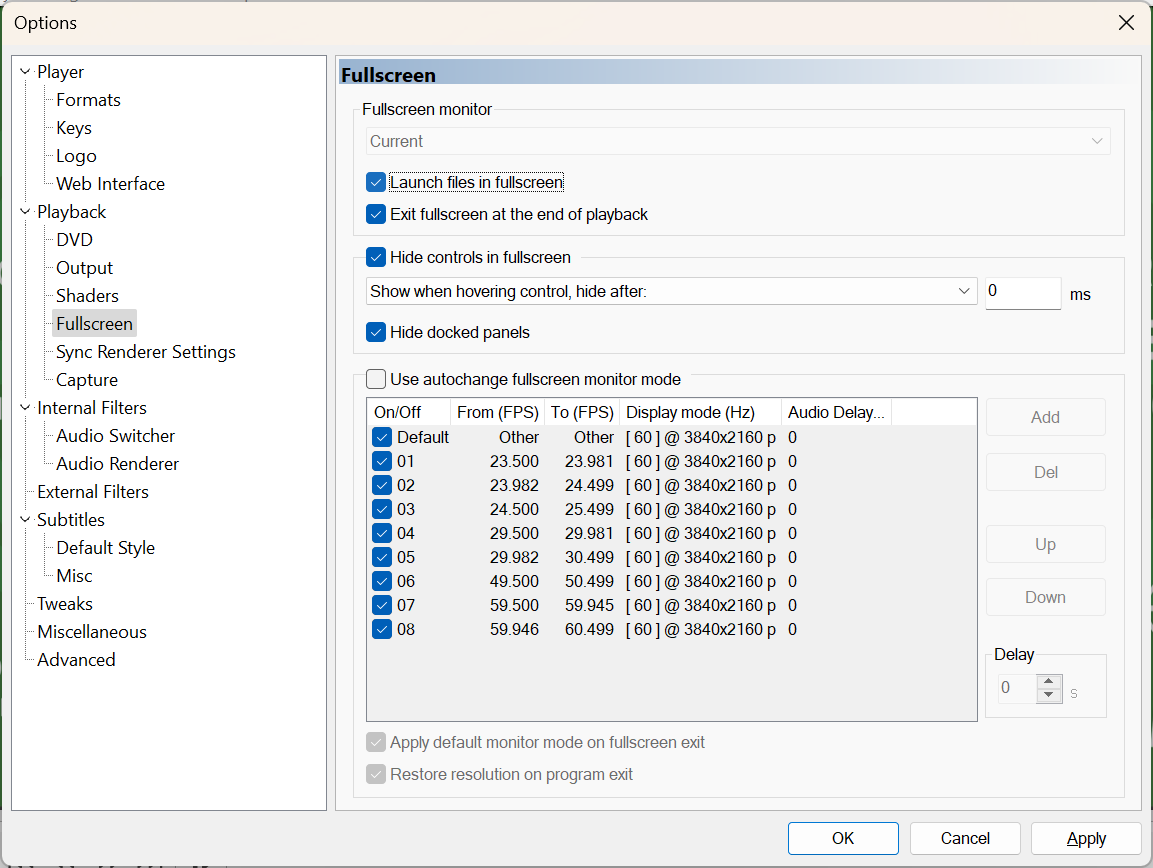
This provides the FullScreen 3D format view that we need, in this case the default Half Top/Bottom format, for input into VR via the likes of BigScreen or Virtual Desktop:
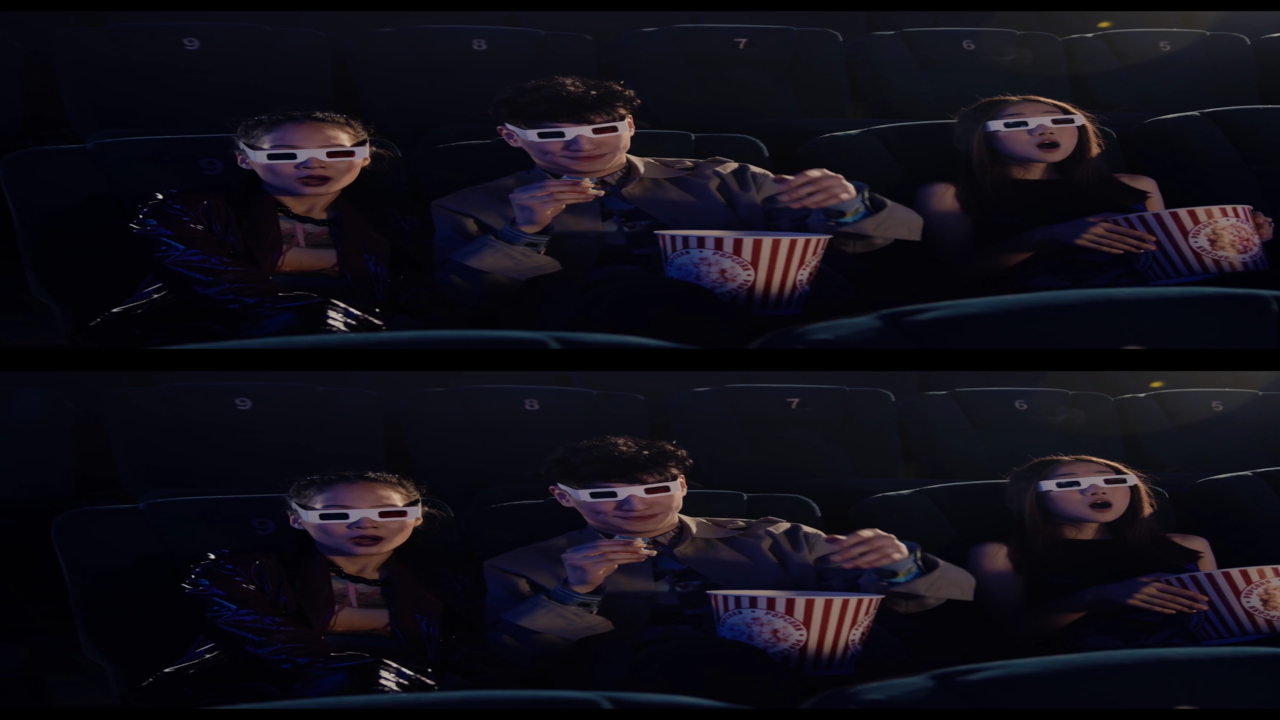
However, there is a little more configuration of MPC-HC to complete. We also need to set it to remember the last played position for recent files, so we can resume playing videos from where we left off. See "View/Options/Player/Remember File Position":

In addition, note that MPC-HC does not remember the file position for videos of less than 10 minutes by default. So, if you want the last play position remembered for short videos change: "View/Options/Advanced/RememberPosForLongerThan" from 10 to 1:
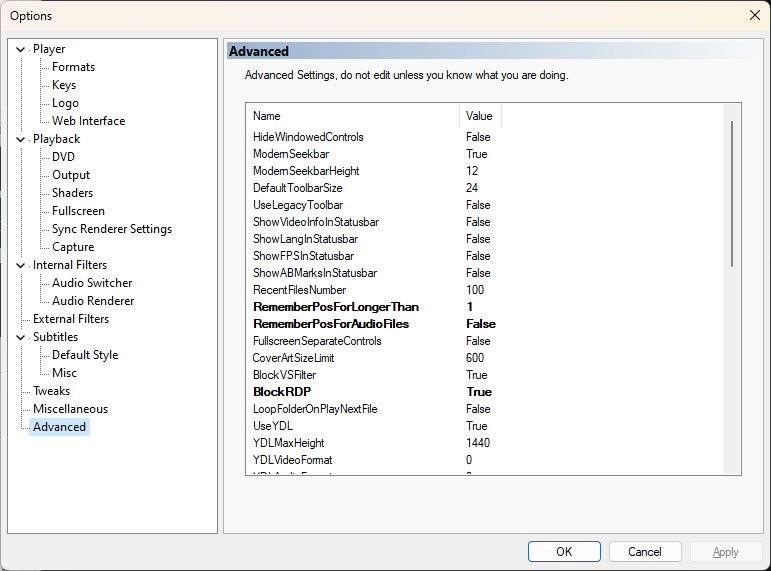
If you had MPC-HC installed previously, then you may have enabled the option to view a preview image of the video on the seek bar. As Stream to 3D generates the video on-the-fly, enabling this option can cause performance problems. You can disable it in the Options under Tweaks as below:

There are similar hot keys and configuration optimisations for other media players. For example, the hot key for Full Screen mode in Pot Player is the "Enter" key. Full screen mode in VLC can be toggled with the "F" key.
To configure PotPlayer to start in FullScreen mode and resume playback from the last position follow the guidance here.
To configure VLC to start in FullScreen mode and resume playback from the last position follow the guidance here.
The MPC-HC and PotPlayer media players should operate without further advanced configuration, once installed.
However, if you have installed VLC, it additionally requires the VLC Avisynth plugin to be configured before use with Stream to 3D for playback via the Play button (alternatively, if your version of Stream to 3D supports it - you can use HTTP Streaming with VLC via the Stream to 3D Streaming function). The Avisynth plugin for VLC will have been downloaded during setup, if selected. Configuration requires a DLL to be copied into place in VLC and some settings changes within VLC itself, see here for further details.
You can pause, go forward and rewind using the controls in the media player when invoked via the Play button. Playback via the Play button invokes the 2D to 3D conversion function, but it does NOT require the video to be encoded before playback begins, by contrast with the Streaming and Conversion functions - this means that it is more efficient than those functions. To stop a video playing you can either use the controls in the media player or press the Stop button in the main menu of Stream to 3D, the latter will also kill the media player process.
The above steps take us to the point where we can play a 2D video and generate output in a 3D format on the PC's screen. However, we have yet to see it in 3D. To achieve that, we next move into VR and utilise a tool that can convert the PC screen into 3D. Both Virtual Desktop and BigScreen are supported for this purpose, but first we need to load the relevant setttings.
If you do not have Virtual Desktop or BigScreen, you can try either the Stream to 3D Streaming or Conversion functions to watch your videos in 3D.
Loading Preset Configurations
You can set all of Stream to 3D settings manually, but it is also supplied with some preset configurations. These include settings for Virtual Desktop and BigScreen Steam VR. To access these click on the "Settings/Load Setttings" menu option in Stream to 3D. You should then see the file open dialog below:

Simply select either the Virtual Desktop or the the BigScreen Steam VR config file for the environment that you will be using to watch your videos and click Load.
The configuratons between Virtual Desktop and BigScreen differ in a couple of respects; the default 3D format for BigScreen is HSBS (Half Side by Side), whereas the default format for Virtual Desktop is SBS (Full Side by Side), in addition BigScreen has a fixed WideScreen (16:9) aspect ratio in all of its environments - so Stream to 3D forces this 16:9 aspect ratio on the video before converting it to 3D (by Vertical or Horizontal Zoom - depending on the aspect ratio of the original video).
You can change these settings manually and indeed save your own configurations in differently named config files.
Watching a 2D Video in 3D with Virtual Desktop
The full installation and setup of Virtual Desktop is outside the scope of this guide. However, the essential steps are given below:
- Install the Virtual Desktop streamer application on your PC.
- Install the Virtual Desktop application in your VR Headset.
- View your PC's Desktop within your headset via Virtual Desktop.
- Play video on PC Desktop via Stream to 3D.
- Use Virtual Desktop's view options to switch to a 3D SBS or TB video view and watch the video in 3D in your headset.
You can find installation details and the Virtual Desktop streamer application here.
The video below provides an example of using Virtual Desktop with Stream to 3D to play a 2D video in 3D in an Oculus Quest 2 headset. The system details used for this demonstration are the same as those described for proving here.
The laptop PC employed is running a 4K desktop view. The Oculus Quest 2 headset is connecting wirelessly, with the headset in a different physical room to the laptop, but in the same room as one of the DECO X20 AX1800 mesh WIFI nodes used in this system setup.
The 2D trailer used in the demonstration is 1080p resolution. The video uses the Virtual Desktop Home Cinema environment.
The video also shows switching between Full SBS and Half SBS formats:
The video ends with the launch of a Steam VR environment using the Steam VR menu option in Virtual Desktop. This environment is then used to launch the BigScreen Steam VR application in the next demonstration video:
Watching a 2D Video in 3D with BigScreen Steam VR
As with the Virtual Desktop case, the full installation and configuration of Big Screen Steam VR is outside the scope of this guide. However, the essential steps are given below:
- Install the Bigscreen Remote Desktop application on your PC.
- Install the BigScreen Steam VR application in your Steam environment and access it from your VR Headset.
- View your PC's Desktop within your headset via the BigScreen Steam application.
- Play video on PC Desktop via Stream to 3D.
- Use BigScreen's Desktop view options to switch to a 3D SBS or OU/TB video view and watch the video in 3D in your headset.
BigScreen, like Virtual Desktop, has options to interpret the desktop view as a 3D SBS or OU/TB video view and so present the video being played on the PC in 3D within the headset. Note that BigScreen only supports Half SBS and Half OU/TB formats, not Full SBS (Virtual Desktop supports Full SBS in addition to Half SBS and Half TB). You can find installation details and the BigScreen Remote Desktop application here.
The video below shows a 2D to 3D real-time converted video being played in the Sci-Fi cinema environment. It begins by showing the switch from the Big Screen Home environment into the Sci-Fi environment, before the video is played.
The BigScreen Stream to 3D settings should be loaded before playing your videos.
The BigScreen keyboard is accessible through the BigScreen "Tools & Toys" menu. The "Windows Key + Tab" button on the keyboard is particularly useful for switching between the media player and the Stream to 3D PC applications.
The 3D SBS view in BigScreen is enabled through its "Desktop/3D Setting" option. You can choose between SBS (this is actually Half SBS format), OU (Over/Under) (also known as TB (which for BigScreen is actually Half Top Bottom)) or 2D.
Remember to turn the 2D view back on before using the "Windows Key + Tab" to switch applications so that you have a clear view of the desktop applications while switching:
Click here to go to the Usage and Configuration home page.